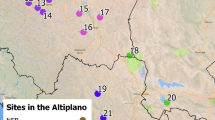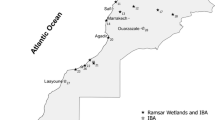Abstract
Rice fields are an alternative habitat for waterbirds and provide food and shelter for many avian species, but there is a lack of information about how the use of rice fields translates into population level effects. The aim of this study was to test the relationship between the use of rice fields by European waterbirds and trends in their populations. We tested this relationship during the autumn migration season and during the breeding season. Based on counts conducted over the last 23 years in natural marshes and areas of rice fields in Doñana (SW Spain), an index of rice field use was constructed for 76 bird species, which was then compared to these species’ European population trends obtained from the literature. A positive relationship was found between waterbird population trends and the use of rice fields during autumn migration season. Our study suggests that changes in the Common Agriculture Policy in Europe leading to reductions in areas of rice cultivation may have important effects on waterbirds. The restoration of former marsh areas and the maintenance of rice cultivation would seem to be more environmentally friendly approaches than the use of these areas to grow alternative crops or solar farms.

Similar content being viewed by others
References
Abend L (2008) Spanish solar firms accused of fraud, Nature News. doi:10.1038/news.2008.1326
Ackerman JT, Takekawa JY, Orthmeyer DL, Fleskes JP, Yee JL, Kruse KL (2006) Spatial use by wintering greater white-fronted geese relative to a decade of habitat change in California’s Central Valley. J Wildl Manag 70:965–976
Acosta M, Mugica L, Mancina C, Ruiz X (1996) Resource partitioning between Glossy and White Ibises in a rice field system in southcentral Cuba. Waterbirds 19:65–72
Bird JA, Pettygrove GS, Eadie JM (2000) The impact of waterfowl foraging on the decomposition of rice straw: mutual benefits for rice growers and waterfowl. J Appl Ecol 37:728–741
Bolduc F, Afton AD (2004) Relationships between wintering waterbirds and invertebrates, sediments and hydrology of coastal marsh ponds. Waterbirds 27:333–341
Burnham KP, Anderson DR (2002) Model selection and multimodel inference: a practical information-theoretic approach, 2nd edn edn. Springer-Verlag Inc, New York
Canepuccia AD, Isacch JP, Gagliardini DA, Escalante AH, Iribarne OO (2007) Waterbird response to changes in habitat area and diversity generated by rainfall in a SW Atlantic coastal lagoon. Waterbirds 30:541–553
Cramp S, Simmons KEL (eds) (1977–1985) Birds of the Western Paleartic: Handbook of the Birds of Europe, the Middle East and North Africa. vol I–IV. Oxford University Press. Oxford
Czech HA, Parsons KC (2002) Agricultural wetlands and waterbirds: a review. Waterbirds 25 (Special Publication 2):56–65
Delany S, Scott D (2006) Waterbird Population Estimates, 4th edn. Wetlands International, Wageningen
Den Held JJ (1981) Population changes in the Purple Heron in relation to drought in the wintering area. Ardea 69:185–191
Donald P, Green R, Heath M (2001) Agricultural intensification and the collapse of Europe’s farmland bird populations. Proc R Soc 268:25–29
Donald P, Sanderson F, Burfield I, Van Bommel F (2006) Further evidence of continent-wide impacts of agricultural intensification on European farmland birds, 1990–2000. Agric Ecosyst Environ 116:189–196
Duncan P, Hewison AJM, Houte S, Rosoux R, Tournebize T, Dubs F, Burel F, Bretagnolle V (1999) Long-term changes in agricultural practices and wildfowling in an internationally important wetland, and their effects on the guild of wintering ducks. J Appl Ecol 36:11–23
Elphick C, Oring L (1998) Winter management of Californian rice fields for waterbirds. J Appl Ecol 35:95–108
Elphick C, Oring L (2003) Conservation implications of flooding rice fields on winter waterbird communities. Agric Ecosyst Environ 94:17–29
Enggass P (1968) Land reclamation and resettlement in the Guadalquivir delta-Las Marismas. Econ Geogr 44:125–143
FAOSTAT (2004) Agriculture. Food and Agriculture Organization of the United Nations. Rome, Italy. http://faostat.fao.org. Accessed 1 Nov 2008
Fasola M, Ruiz X (1996) The value of rice fields as substitutes for natural wetlands for waterbirds in the Mediterranean Region. Waterbirds 19:122–128
Fasola M, Rubolini D, Merli E, Boncompagni E, Bressan U (2010) Long-term trends of heron and egret populations in Italy, and the effects of climate, human-induced mortality, and habitat on population dynamics. Popul Ecol 52:59–72
Ferrero A, Nguyen N (2004) Constraints and opportunities for sustainable development of rice-based production systems in Europe. In: FAO Rice Conference, Rome, Italy:12–13
Finlayson C, Hollis GE, Davis TJ (1992) Managing Mediterranean wetlands and their birds. International Waterfowl and Wetlands Research Bureau and Istituto Nazionale di Biologia della Selvaggina. Special Publication No. 20, Slimbridge
García-Novo F, Martín-Cabrera C (2005) Doñana: Agua y biosfera. UNESCO/Ministerio de Medio Ambiente, Madrid
Gauthier G, Giroux JF, Reed A, Béchet A, Bélanger L (2005) Interactions between land use, habitat use, and population increase in greater snow geese: what are the consequences for natural wetlands? Glob Chang Biol 11:856–868
González-Solís J, Bernadi X, Ruiz X (1996) Seasonal variation of waterbird prey in the Ebro delta rice fields. Waterbirds 19:135–142
Kanyamibwa S, Schierer A, Pradel R, Lebreton JD (1990) Changes in adult annual survival rates in a western European population of the white stork Ciconia ciconia. Ibis 132:27–35
Lemoine N, Bauer HG, Peintinger M, Bohning-Gaese K (2007) Effects of climate and land-use change on species abundance in a central European bird community. Conserv Biol 21:495–503
Long PR, Szekely T, Kershaw M, O’Connell M (2007) Ecological factors and human threats both drive wildfowl population declines. Anim Conserv 10:183–191
Lourenço PM, Piersma T (2008) Stopover ecology of black-tailed godwits Limosa limosa in Portuguese rice fields: a guide on where to feed in winter. Bird Study 55:194–202
Maeda T (2005) Bird use of rice field strips of varying width in the Kanto plain of central Japan. Agric Ecosyst Environ 105:347–351
Murphy M (2003) Avian population trends within the evolving agricultural landscape of eastern and central United States. Auk 120:20–34
Nivet C, Frazier S (2004) A review of European wetland inventory information. Report prepared in the framework of ‘A pilot study towards a Pan-European Wetland Inventory’. Wetlands International
Rendón MA, Green AJ, Aguilera E, Almaraz P (2008) Status, distribution and long-term changes in the waterbird community wintering in Doñana, south-west Spain. Biol Conserv 141:1371–1388
Sánchez-Guzmán JM, Moran R, Masero JA, Corbacho C, Costillo E, Villegas A, Santiago-Quesada F (2007) Identifying new buffer areas for conserving waterbirds in the Mediterranean basin: the importance of the rice fields in Extremadura, Spain. Biodivers Conserv 16:3333–3344
Sanderson F, Donald P, Pain D, Burfield I, Van Bommel F (2006) Long-term population declines in Afro-palearctic migrant birds. Biol Conserv 131:93–105
Shultz S, Bradbury RB, Evans KL, Gregory RD, Blackburn TM (2005) Brain size and resource specialization predict long-term population trends in British birds. Proc R Soc 272:2305–2311
Van Groenigen JW, Burns EG, Eadie JM, Horwath WR, Van Kessel C (2003) Effects of foraging waterfowl in winter flooded rice fields on weed stress and residue decomposition. Agric Ecosyst Environ 95:289–296
Wretenberg J, Lindström A, Svensson S, Pärt T (2007) Linking agricultural policies to population trends of Swedish farmland birds in different agricultural regions. J Appl Ecol 44:933–941
Acknowledgments
The Junta de Andalucía funded this study via the project contract “Las aves acuáticas de Doñana y el cultivo del arroz: la interacción entre la agricultura y la conservación de las zonas húmedas”. Gregorio M. Toral was funded by an I3P-CSIC grant for the formation of Researchers. The “Equipo de Seguimiento de Procesos Naturales” belonging to the Doñana Biological Station (C.S.I.C.) has been collecting the census data used in this study for many years.
Author information
Authors and Affiliations
Corresponding author
Rights and permissions
About this article
Cite this article
Toral, G.M., Figuerola, J. Unraveling the importance of rice fields for waterbird populations in Europe. Biodivers Conserv 19, 3459–3469 (2010). https://doi.org/10.1007/s10531-010-9907-9
Received:
Accepted:
Published:
Issue Date:
DOI: https://doi.org/10.1007/s10531-010-9907-9




